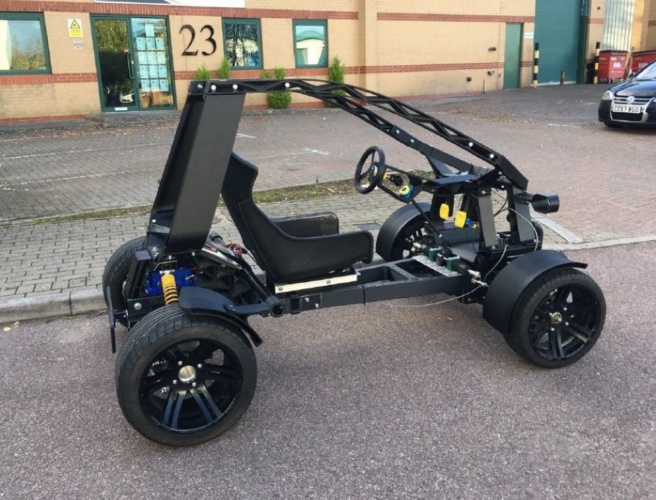One of the pioneers of 3D printing cars, Local Motors, may have shifted toward autonomous public transportation, but that doesn’t mean other companies aren’t still exploring the additive production of personal vehicles. The latest is a British firm called Scaled Ltd, which has unveiled an electric, four-wheel 3D printed vehicle dubbed the Chameleon.
For Scaled, the Chameleon is a demonstrator project, meant to showcase the possibilities of large-scale additive manufacturing (AM) using the company’s systems. Scaled was founded in 2015 and hosts both gantry 3D printers and an industrial robotic arm outfitted with thermoplastic extrusion printheads. The robotic arm is capable of 3D printing objects up to three meters in length.
Designed and manufactured in just a few months, the Chameleon was designed using stochastic software from Rafinex, which made it possible to optimize the chassis of the vehicle in response to a variety of loading conditions. The material used to produce the car was PA6 from the Lehvoss Group, meant to be durable enough for driving.
“Thirty-three per cent of the vehicle included a recycled PA6 from a UK firm, Hills Premier Polymers,” said Bob Bradley, Co-founder and Technical Director of Scaled. “In the future it will definitely be possible to up the amount of circular plastics in use for this type of thing – something we are very excited about.”
The non-3D printed components were created with assistance from students on Birmingham University’s Racing Team. Weighing in at 150 kg, the vehicle runs on a Lynch electric motor and can travel up to 45 mph.
You’ll note from the pictures that the Chameleon lacks many of the features one might associate with a street-legal car and resembles more closely a golf cart. While the UK startup is focused on the automotive sector, it does not yet appear that its primary goal is to become a 3D printed vehicle manufacturer.
If it did head down that path, it would have to contend with the likes of LM Industries (LMI), the parent company of Local Motors, which more or less gave up on personal 3D printed vehicles in lieu of its autonomous 3D-printed shuttle, Olli. Then there’s Divergent 3D/Czinger, directed at the luxury super- and hyper-car market. The closest direct competitor would be Italian firm XEV, which claims to have up to 30,000 orders for its small, 3D printed electric vehicles.
For the time being, the 3D printing of vehicles remains isolated to high-end, specialty applications, rather than personal car ownership. In the case of Divergent 3D/Czinger, that means only the ultra-high-performance types of sports cars the wealthy can afford. Otherwise, we see a number of auto sports teams using the technology for their races and some luxury manufacturers incorporating 3D printed end parts into their vehicles. When it comes to consumers, large brands have been experimenting with small and limited-run 3D printed mods, but it will still be awhile before cars with 3D printed chasses are really ready for the road. The military, however, may find some use for it sooner than consumers.
According to SmarTech Analysis report “Additive Manufacturing for Automotive Part Production – 2019 – 2029”, LMI may be signaling the primary method in which the public does encounter 3D printed vehicles. The report states:
“A number of application cases indicate that 3D printing technologies will be a key manufacturing process for the production of tomorrow’s smart EV fleets. One example is the OLLI self-driving, 3D-printed shuttle, developed for use in smart mobility across city centers or enclosed company HQs and business parks.”
LMI is not the only company to pursue this opportunity. The aforementioned Italian manufacturer, XEV, has pitched “customized enterprise vehicles” to businesses like such as the Italian Post, Arval Leasing Company, Q8 Petroleum Company (Kuwait Petroleum Company), and Campello Motors. Because not everyone can afford the $1 million Big Area Additive Manufacturing system that LMI uses to produce Olli, they may actually turn to firms like Scaled for lower-cost production.
Subscribe to Our Email Newsletter
Stay up-to-date on all the latest news from the 3D printing industry and receive information and offers from third party vendors.
You May Also Like
Gorilla Sports GE’s First 3D Printed Titanium Cast
How do you help a gorilla with a broken arm? Sounds like the start of a bad joke a zookeeper might tell, but it’s an actual dilemma recently faced by...
Nylon 3D Printed Parts Made More Functional with Coatings & Colors
Parts 3D printed from polyamide (PA, Nylon) 12 using powder bed fusion (PBF) are a mainstay in the additive manufacturing (AM) industry. While post-finishing processes have improved the porosity of...
$25M to Back Sintavia’s Largest Expansion of Metal 3D Printing Capacity Since 2019
Sintavia, the digital manufacturing company specializing in mission-critical parts for strategic sectors, announced a $25 million investment to increase its production capacity, the largest expansion to its operations since 2019....
Velo3D Initiates Public Offering in a Bid to Strengthen Financial Foundations and Drive Future Growth
Velo3D (NYSE: VLD) has been among a number of publicly traded 3D printing firms that have attempted to weather the current macroeconomic climate. After posting a challenging financial report for 2023,...
































